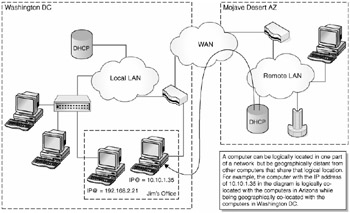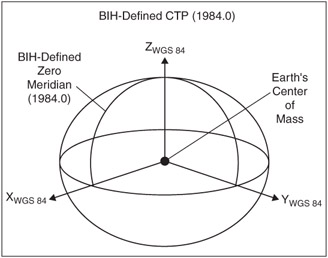Introduction
Defining Location
Location is a quantity which is so fundamental that it forms part of the gestalt of every human being. Everyone has an instinctive sense of what is meant by location, and yet if you were to ask for a definition of the term you might be surprised by the varied responses it would elicit. Ask somebody "Where are you now?" and you will get responses ranging from "I'm at home," "I'm in the car," "I'm at 27 Homebay Drive, Watsonia,"-or going to the extreme of subjectivity: "I'm in a state of confusion." In very rare circumstances, somebody may actually reply "I'm 32 degrees south latitude and 150 degrees east longitude…." All of the preceding are potentially correct and are expected responses, depending completely on the context within which the questions were asked. But in discussing location in this book, at least some refinement of the term is needed.
As a starting point, location in this book refers to "geographical location." That is, it is concerned with a spatial location associated with a physical point or region relative to the surface of the earth. It does not refer to other types of location such as a logical network location. For example, an IP device will certainly have a physical spatial location, but the IP address does not represent that location. The IP address represents a logical network location; it identifies the network and host-ID associated with the device and tells internetworking elements how to route the packets so they arrive at the correct network location. There is no direct correspondence between this location and the geographical location. They are not equivalent, as shown in Figure 1, and the process of going from an arbitrary IP address to a location is much more involved than a simple static translation from one to the other.

Figure 1: Logical network location versus geographic location.
It is evident that context is a major consideration when even spatial location is being discussed. If someone says they are "in the car," then that may be all that is important in terms of the application of the dialog which is occurring with them. It may not be important what the geospatial coordinates of the car are, or the coordinates may be quite implicitly associated with the car. This version of location ("in the car") can be called application-specific. In other words, it is a version of the information which is relevant to the discussion at hand and which could mean something very different in another discussion-for instance, in another application. If location information is being sourced from a network element that is independent of the application using the location, then a more application-independent form of location information is desirable.
There is a form of location which is less open to interpretation, that is application-independent, and whose meaning tends to be immutable even over extensive periods of time. This is the geodetic form of location and it is generally expressed in degrees north or south of the equator, and east or west of the zeroth meridian. Given a well-defined shape for the Earth (a defined geoid; see Figure 2) and specific locations for zero coordinates, and allowing that it is the position relative to the surface of the Earth that is of interest despite the Earth's unceasing wandering against the backdrop of the greater universe, then the geodetic form provides a thoroughly objective and immutable form of location. The World Geodetic System of 1984 (WGS 84) specification (see Reference 1 at the end of the introduction) is an example of such an application-independent system for defining geographic location.

Figure 2: The standard Earth geoid, as defined in WGS 84.
While geodetic form provides a definitive form of application-independent location specification, it is not a form which humans frequently use. One of the most common forms of location specification used by humans is the "civic address" form. This is commonly thought of in terms of the familiar street number, street name, municipality/city, state, and country form. There are a number of documented forms for such addresses (see References 2 and 3). Indeed, the variation in the civic address form across international jurisdictions is considerable. Street numbers do not exist in all jurisdictions, for example, and the naming of streets is also subject to considerable variation. Further, the scope of a given civic address form may vary depending on application. For instance, a room and building number may be definitive in the scope of a single business campus, but they do not provide a globally definitive location since they don't actually tell you where on earth that building is. Despite the scope for variation in the civic form of location, however, it is a familiar one which maintains a good degree of application-independence within a significant subset of all location-based applications.
In the rest of this text, when location is discussed, the meaning of the term location will refer to a spatial geographic location in either geodetic form or civic address form. Any other definition of the term will be identified where it is used in the text.
EAN: 2147483647
Pages: 129